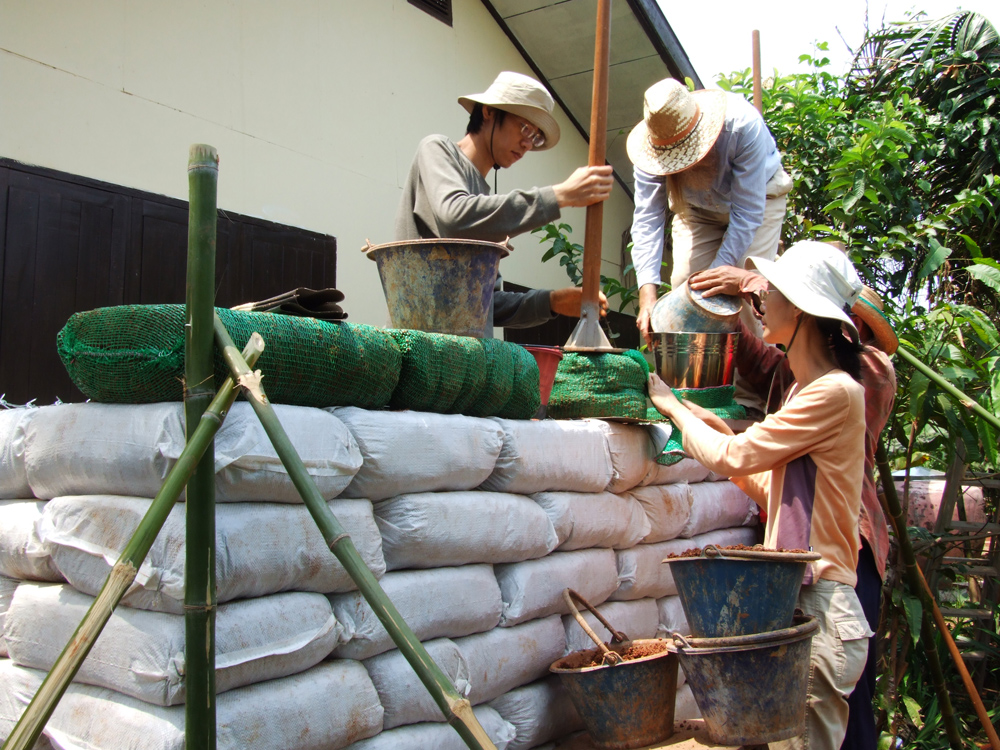
I finally had a chance to build with mesh bags. Previously I had made some test bags, but this week we included a whole course of mesh bags in our current Cool Pantry project. More photos coming soon.
In this post I want to describe some of the differences in working properties between mesh and poly bags. Bag properties will vary between suppliers, so your experience may be different, but with our bags the results so far are very positive in favor of mesh bags in most every way.
– 1/4 the cost of poly bags in our area! (6.5 cents versus 27 cents.) This savings would be substantial on a full sized home. The cost difference is largely due to buying recycled bags at the farmer’s market. We’re using a product that’s in perfect condition, but would likely be thrown away. Poly bags have more uses and fetch higher prices even when recycled.
– Can add an additional 1-2 extra buckets per bag (6-7 versus 5). This creates longer bags with more overlap, which creates stronger walls.
– Can tie the tops of bags with one 4” piece of galvanized wire. I twist the bag closed, insert one end through the mesh, bend the wire over and poke the other end into the contents. This means you can use half the wire and close the bag in about one third the time of our typical method. (Small improvements like this add up over time.)
– Faster plastering due to better bond. (We’ve yet to verify this, but this is what I expect.) A previous post discussed improved bonding strength, but plaster work should go faster as well.
– We pounded the mesh bags very hard because the bond beam sits on this course, and yet there was no damage to the mesh.
– There was extensive drying in just a few hours.
Other comments:
– A slightly moister mix will reduce spillage through the mesh. Only 2-3 teaspoons of fine material fall out with this method.
– Requires a smaller bucket chute. We’re using a 3 gallon (11.4 liter) stainless steel bucket with the bottom and handle cut off. It’s 9” high and tapers from 11” wide at the top to 8”.
– A plastic bucket of similar size broke almost immediately. (Anyone else getting fed up with crap tools?) Might as well pay a little extra and have something that will last for years.
– Mesh bags are stretchier and take a second or two longer to insert the bucket chute.
– Mesh can tear if hit hard with the corner of a tamper. Round the edges of your tampers and hit the bags flat. (None of our bags tore, but this is something to watch out for.)
– Someone could experiment with double bags for seismic areas and report back their results.
Refer to our previous blog posts for more info:
Hyperadobe Update from Brazil
Open Weave Fabric: Ideal Working Properties
Hyperadobe Continued

Owen, when will your earthbag book be available? I’d be very interested in acquiring a copy. I’m considering building a good-sized earthbag home, or series of pods for me, two children, two dogs, plenty of stuff and space for my g/f and her son. That’s two adults, three children, two dogs and all the stuff that comes with them so I will want to build plenty of closet/storage space into my design as well. I’m hoping your book may extend on my theory and give me some examples to use when i go to battle for licenses to build my structure. :)
It’s been finished for months. http://www.earthbagbuilding.com/articles/ebbuildingguide.htm
i think i will be using mesh bags on my upcoming project.
i’ve seen it stated that barbed wire will not be needed with mesh bags as opposed to poly bags except if building a dome.
I would like to eliminate the barbed wire if possible in the construction of my dome.
The disadvantages that i see with it are:
difficulty working with it, more expense, and rust (should water penetrate the walls).
I’m thinking about replacing the barbed wire with nylon rope, knotted every few feet, and if necessary staked or stapled in place.
(If extra reinforcement of the wall were needed i think it may be possible to use larger stakes nailed through the knots in the rope to join several courses of tubes together.)
i think the nylon rope would provide the tensile support the barbed wire provides but would be easier to use and cheaper.
what do you think?
This subject is covered in my upcoming earthbag book. There is growing consensus that barbed isn’t needed on simple structures in non-seismic areas. You could always choose from a variety of other reinforcing techniques such as rebar or bamboo pins, plaster mesh on both sides of the wall tied together, buttressing, tying courses together with twine, etc.